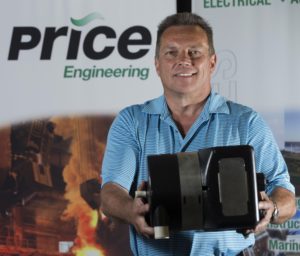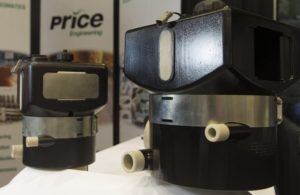Hartland firm says it’s shaking up hydraulic fluid power industry

By Rick Barrett of the Journal Sentinel
6/21/16 6:20 p.m.
A Hartland firm says it’s stepping up technology aimed at making big machines, such as garbage trucks and construction equipment, more efficient and better for the environment.
Price Engineering made its announcement Tuesday at a fluid power technology conference that continues Wednesday, from 8 a.m. to 5 p.m., at Milwaukee School of Engineering.
Price says it’s collaborated with Solar Plastics, of Delano, Minn., on the development and manufacture of new hydraulic fluid systems that, in some cases, reduce the amount of toxic, mineral-based fluid used by more than 90%.
Hydraulic motors use fluid under pressure to generate, control and transmit power. Among thousands of uses, they turn the drum on a cement mixer, swing the boom on a crane, and power the lifting equipment on a garbage truck.
Hydraulic reservoirs hold the fluid, the lifeblood of the motors. Often they’re big, inefficient, and haven’t changed much in design in the last 30 years.
Price has expanded the use of what’s called cyclone technology, which rapidly removes suspended air from hydraulic fluid. By doing that, the size of a fluid reservoir can be dramatically reduced, saving hydraulic fluid and making the system more environmentally friendly.
“I think it’s disruptive technology,” said Terry Glidden, Price Engineering managing director.
The cyclonic system originated from Eaton Corp. 17 years ago, but Price Engineering says it’s taken the technology to a higher level through numerous changes.

Hydraulic pumps provide the muscle for equipment used in construction, mining, agriculture, forestry and transportation.
“These are the things that are all around us, but we aren’t always aware of them,” said Price Engineering President Tom Price.
The company uses 3-D printers to rapidly develop working prototypes of hydraulic fluid reservoirs. In some cases, it has managed to shrink the size of a reservoir that held 8 gallons down to the size of a milk jug.
“I think we are at a crossroads; some people call it the next industrial revolution, the digitization of machinery,” Price said.
A traditional hydraulic fluid reservoir could contain up to five times the amount of oil that the pump can handle in a minute. Thus, even a 20-gallon-per-minute system would need up to 100 gallons of oil.
The environmental benefits from smaller, more efficient hydraulic fluid systems come in several ways.
The petroleum-based fluid is toxic, for instance, and if there’s less to spill there’s less to clean up. That’s especially important in a marine environment, Price said
Moreover, in some cases biodegradable oil can replace the mineral-based hydraulic fluid.
“The trends that we see that are important are not only modern technology, productivity and energy efficiency, but also working in a global environment where we leave the world to the next generation in a better place,” Price said.
“We haven’t been as good of stewards as we should be. I think there’s a real call to executives and manufacturing leaders to rethink how we do some things,” he added.
Price Engineering has won U.S. military contracts for its compact hydraulic fluid reservoirs, with the equipment installed on a new prototype vehicle from Oshkosh Corp.
Manufacturers of even the largest trucks value every square inch of space in their designs.
“When you open the hood of some of these vehicles, there’s hardly room left for a pad of paper,” Glidden said.
The Fluid Power Institute, at Milwaukee School of Engineering, has done industry-funded research for off-road equipment makers Caterpillar, John Deere and Case-New Holland.
Researchers also are seeking ways to scale-down fluid power applications to human size for prosthetics.
“It’s almost like the ‘bionic man’ is going to be a reality at some point soon, the way things are going in the medical field,” said Thomas Wanke, director of the Fluid Power Institute.
Research is under way for using hydraulic fluid power for offshore power generation, essentially tapping the motion of waves to generate electricity. The wind-turbine industry also uses a lot of fluid power in its equipment.
“Those areas are continuing to grow,” Wanke said. “And we are doing a lot of research in hydraulic fluids to improve the efficiency of pumps and motors. If they’re using less fuel, they’re producing less pollution.”
The fluid power technology conference, at MSOE’s Kern Center, includes a trade show and 45-minute presentations of technical papers. Registration for the event, sponsored by Fluid Power World magazine, is available online or at the event.
